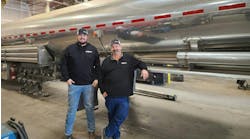Trailer backlogs continue to swell, according to this quarter’s issue of ACT Research’s Trailer Components Report.
With only a portion of the 2023 US trailer orderboards open and 2022 production slots “full in aggregate,” backlog-to-build ratios for the industry already stretch well into 2023, ACT noted.
“Until orderboards are opened deeper into next year, we expect orders and production to travel in lockstep. That said, demand remains strong, despite increased pricing, and cancellations, although ticking upward, are insignificant, as fleets in queue need the equipment and plan to stay in queue until orders are converted to deliveries,” said Jennifer McNealy, director-CV market research and publications at ACT Research. “When more 2023 production slots become available, we anticipate a surge of orders to be ‘officially’ accepted.”
While Demand remains strong, ACT research suggested that the current “cyclical” strength is not likely to last through 2023 with a “mild recession” now in the forecast.
“Inflation continues to impact OEMS. Difficulty in projecting part and material prices has made it difficult for manufacturers to set firm prices for trailers currently on order,” Eric Crawford, ACT Research’s vice president, senior analyst, said.
So build plan projections have changed “significantly” over the past three months.
“For 2022, easing supply-chain disruptions and still-strong demand have led us to increase our total US trailer build forecast. That said, higher interest rates and our view that a recession is inbound have led us to reduce our 2023 and 2024 forecasts,” Crawford added. “With supply and demand out of sync, and expected to remain there for the near-to-medium term, there is little incentive for a fleet to leave the order board when they already have a committed production slot. While build slot and pricing might not be as firm as fleets would prefer, it’s better than being on the outside looking in.”
ACT Research’s U.S. New Trailer Components and Materials Forecast includes near-term quarterly predictions for two years, while the latter three years of the forecast are shown in annual details. Additionally, analysis is segmented into two categories: those needed for the structural composition of new trailers and those used in the production of undercarriage assembly.









